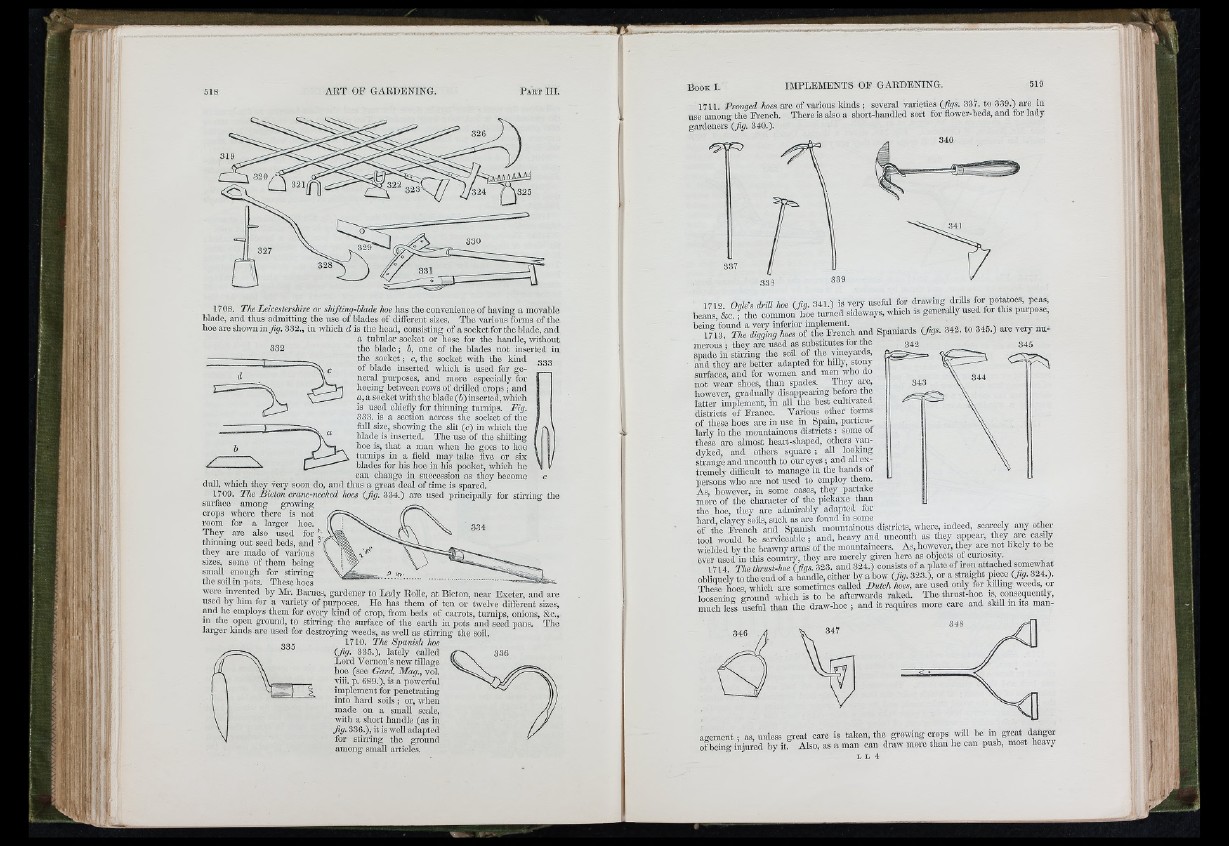
m( 1 1 1
1708. The Leicestershire or shifting-hlade hoe has the convenience of having a movable
blade, and thus admitting the use of blades of different sizes. The various fonns o fth e
hoc arc shown in Jig. 332., in wliich d is the head, consisting of a socket for the blade, and
332
a tubular socket or hose for the handle, without
the b la d e ; h, one of the blades not inserted in
the socket; c, the socket with the kind
of blade inserted which is used for general
purposes, and more especially for
hoeing between rows of drilled crops; and
a, a socket with the blade (6) inserted, which
is used chiefly for thinning turnips. Fig.
333. is a section across the socket of the
full size, showing the slit (c) in Avhich the
blade is inserted. The use of the shifting
hoc is, that a man when he goes to hoe
timiips in a field may take five or six
blades for his hoe in his pocket, Avhich he
can change in succession as they become
dull, which they veiy soon do, and tlius a gi-cat deal of time is spared.
1709. The Bicton crane-necked hoes {Jig. 334.) are used principally for stirring the
surface among growing
crops where there is not
room for a larger hoe.
They are also used for
thinning out seed beds, and f (
tlicy are made of various
sizes, some of them being
small enough for stirring
the soil in pots. Tliese hoes
Averc invented by Mr. Bai-nes, gardener to Lady Rolle, at Bicton, near Exeter, and are
used by him for a variety of purposes. He has them of ten or twelvc different sizes,
and he employs them for every kind of crop, from beds of carrots, turnips, onions, &c.,
in the open ground, to stirring the surface of the earth in pots and seed pans. The
larger kinds arc used for destroying weeds, as Avell as stin-ing the soil.
«o- 1710. The Spanish hoe
{Jig. 335.), lately called
Lord Vernon’s new tillage
hoe (see Gard. Mag., vol.
viii. p. 689.), is a poAverful
implement for penetrating
into hai-d soils ; or, Avhen
made on a small scale,
Avith a s h o r t h a n d l e ( a s in
Jig. 336.), i t i s A vcll a d a p t e d
for s t i i r i n g t h e g r o u n d
a m o n g sm a l l a r t i c l e s .
Book I.
1711. Pronged hoes arc of various kinds ; several varieties {Jigs. 337. to 339.) are in
use among the French. There is also a short-handled sort for floAver-beds, and for lady
gardeners {Jig. 340.).
^ 340
337
333 339
1719 Dale’s drill hoe ( fio a i l . ) is Toiy useful for drawing driUs for potatoes, peas,
b e l n s , ¿ e f s i d J w a y s , winch is generally used for this purpose,
‘"«"i Spaniards (figs. 342. to 345.) ai-e very nu-
meroiis; they are used as substitutes for the <’'««7
spade in staring the soil of the yincyards,
and they are better adapted for hilly, stony
surfaces, and for women and men who do
not weaa- shoes, than spades. They arc,
liowevcr, gradually disappearing before the
latter implement, in all the best cultivated
districts of France. Vai-ious other forms
of tlicse hoes are in use in Spain, particularly
in the mountainous districts : some of
tbese are ahnost heai-t-shaped, others Aran-
dyked, and others squai-e ; all looking
strange and uncouth to oiu* eye s; and all extremely
difficult to manage in the hands of
persons Avho are not used to employ them.
As, however, in some cases, they partake
more of the character of the pickaxe than
the hoe, they are admirably adapted for
bard, clavev soils, such as arc found in some , . .
of the Ib-cuch and Spanish mountainous districts, where, indeed, scarcely any other
tool Avould be serviceable; and, hcaA^y and uncouth as they appear, they are easily
wielded by the braivny arms of the mountaineers. As, hoAvever, they are not likely to be
ever used in this country, they arc merely given here as objects of cimosity.
1714 The thrust-hoe (figs. 323. and 324.) consists of a plate of non attached somewhat
Obliqueiy to the end of a handle, either hy a how (fig. 323.), or a straight piece (fig. 324.).
These hoes, whieli are sometimes called Dutch hoes, are used only for kUhng weeds, or
looseniug ¿round which is to be afterwards raked. The tlnnst-hoe is, oonseqnen ly,
much less useful than the di'aw-hoo ; and it requires more care and skill m its man-
347
agement; as, unless groat care is taken, the growing crops will be in great daiigci
of being injm-od by It. Also, as a man can draw more than he can push, most heavy
L L 4